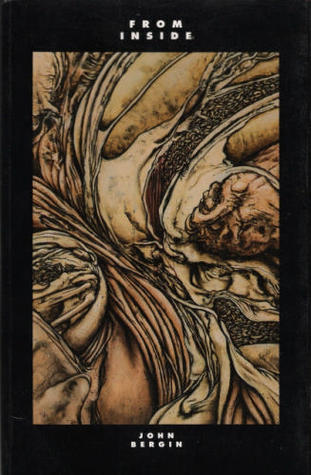 By JOHN BERGIN (Kitchen Sink Press; 1993)
By JOHN BERGIN (Kitchen Sink Press; 1993)
As a veritable epic of sustained surreality this graphic novel is fairly remarkable. It’s also a profoundly dark, gruesome ride, as exemplified by the sepia-toned photos of barbed wire-wrapped dolls and mummified animal carcasses that preface each chapter. It was written and illustrated by the underground artist/musician/filmmaker John Bergin, who combines darkly surreal imagery with a strong narrative drive (which he used for an animated film adaptation, which is likewise highly recommended). Bergin accomplishes this with admirable simplicity and directness, and a paucity of textual captions that let his boldly colored illustrations speak for themselves.
The setting is a train traversing a nightmarish landscape marked by mountains of debris and an ever-expanding ocean of blood. Among the train’s passengers is a young pregnant woman suffering horrific nightmares involving babies on pitchforks and her deceased husband meeting his death (we don’t find out how he actually died, or how the woman ended up on the train, until near the end). The woman’s anxieties, expressed through her nightmares, mirror the devastation of this apocalyptic setting, which often seems a reflection of the woman’s inner torment—or vice versa.
Many challenges are encountered by the woman and her fellow passengers as the train ventures on. A herd of buffalo block the tracks at one point, which is turned into a plus when a makeshift slaughterhouse is set up in one of the train cars. But the buffalo meat runs out before long, resulting in mass starvation and cannibalism. A bit further on the train is halted by a cave-in inside a giant tunnel, wherein the heroine finally gives birth…
Other notables include the rivers of dead infants the heroine is always seeing, a mummified man and his skull-faced dog who tentatively befriend the woman, and the woman’s shocking discovery upon venturing into the train’s back-most cars, which it turns out are left dark and unexplored for a reason!
As for the ending, I found it note-perfect: appropriately bleak and relentless, as befits the overall tone, yet also lyrical and even touching. I know there are those who will criticize FROM INSIDE for being overly grim and/or morbid–as indeed many already have condemned it–so I’ll conclude with the standard it’s-not-for-the-squeamish admonition. But for the non-squeamish among us this can only be classified as a staggering accomplishment.
